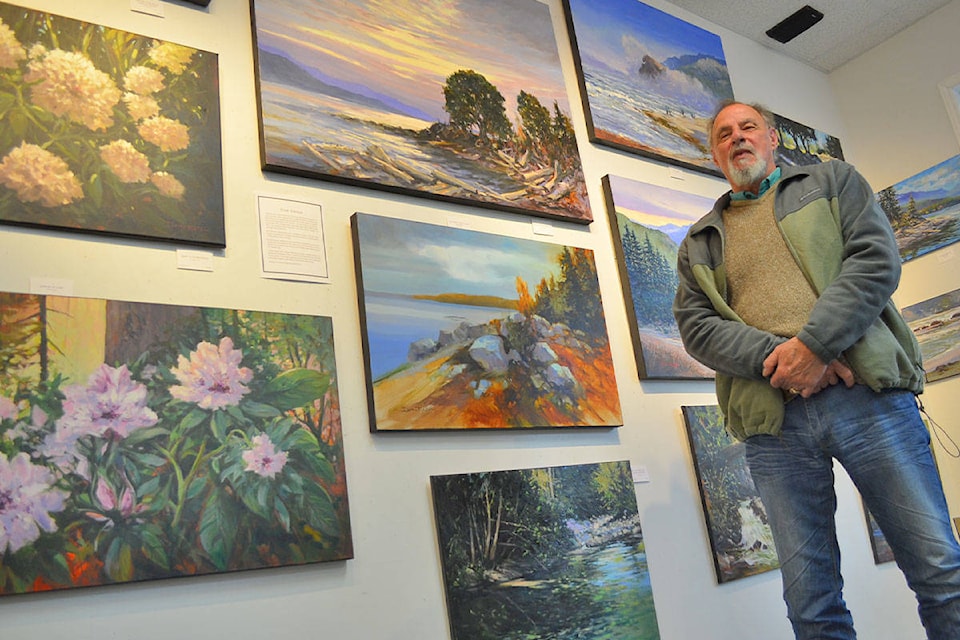Nanoose Bay artist Don Eaton will have his work on display at the Qualicum Art Supply and Gallery in Qualicum Beach through the end of July, offering a unique take on realism.
Born and raised in Duncan, Eaton’s love for nature drew him outdoors to appreciate the wilderness around him.
In his youth, he lived on a farm alongside the Koksilah River and could usually be spotted wandering the shore, fishing and appreciating the display of colours and life next to the water.
In reminiscing about his childhood, Eaton said many years were spent in solitary thought, and looking back now, his memory serves as a patchwork of colours and scents.
READ MORE: TOSH in Qualicum Beach to install banners created by Indigenous artist
He recalls that his love for the arts first took shape while in a junior high art class; a love that has held strong for more than 50 years.
It was the instructor of that art class that introduced him to oil paints, and was also someone he could discuss colour and painting techniques with.
After graduating high school, Eaton left for Vancouver to attend the Vancouver School of Art in the 1970s. Although he was accepted into a four-year program, he left the city after a year, realizing that the rush of city life was not for him.
Eaton also felt that the school did not offer a lot in the artistic direction he wanted to go in, and believed, at that time, he would have appreciated more of a structured curriculum. He also found it hard to fit in, coming from the Island, but still appreciated his time there and credits it as a learning experience.
While in Vancouver, he became a member of the Federation of Canadian Artists, and remained a member for the better part of 15 years.
His work has sold in many different venues across the Island and through the the Lower Mainland. However, through online sales, his work has sold all over the world, including in Uganda, Nigeria and Yemen.
He said he spent a few years giving away his work, mostly to people who expressed a real appreciation for the art, but who couldn’t afford it.
He said giving away his work was incredibly rewarding at the time.
While oil paints are his preferred medium, Eaton said he’s dabbled with watercolours, despite some members of the art community trying to dissuade him away from watercolours, as they believed the medium has a tendency to fade easily, and are not perceived as “permanent.”
Although, Eaton said he has noticed a real shift in the popularity of the medium in recent years.
As many artists do, he has suffered for his work.
In the past, Eaton would insist, to an extreme, on painting plein air through snow and rain. He recalled, in those times, that the paint would go still as it snowed and his fingers would get so cold that he couldn’t hold a paintbrush.
“I found, as I get older, the weather is more of a factor. I’m just not going out there in the pouring rain anymore,” Eaton said with a chuckle.
Many of his pieces on display at the Qualicum Arts Supply and Gallery started as plein air, and then were finished in the studio.
There are even a few he started in the studio, and then took outdoors to finish as plein air.
Eaton considers his style as representational expression, and not solely abstract, although prefers not to use labels to define his work.
“Richard Smith said that every painting is an abstract, even the highly detailed ones.”
A concept of Smith’s, that Eaton agrees with, states that even a photo realistic painting isn’t completely realistic, at least not from the human perspective.
“If you look at an object, and you do photo realism, your eyes can focus here (at one point) but not there (at a different point). So it’s a blur. Its been done in smaller sections of a larger image, which is not how you look at things.”
As an inspiration to Eaton, Smith painted in a way that humans could ‘see,’ where he would focus realistic detail on one or two objects and the rest would be impressions, symbolic of the peripheral vision blur.
